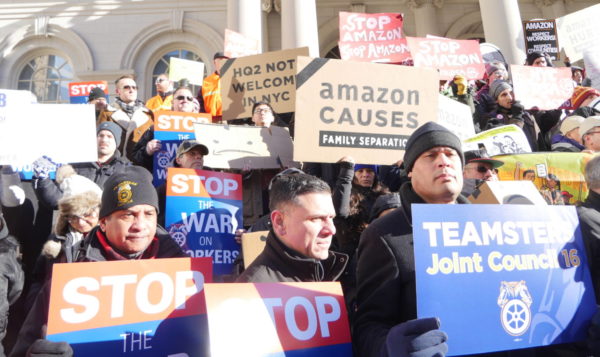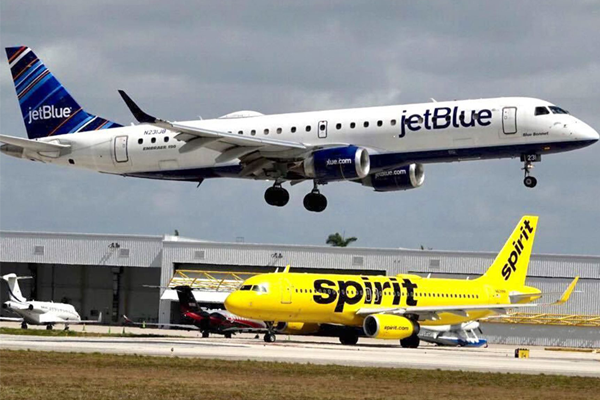New York, NY – Whether or not the deal is really dead, Governor Andrew Cuomo’s efforts to revivify the ashes of “Amazon HQ2” have already succeeded in stoking lots anger and recriminations from everyone involved in the issue. But what’s to be made of the way this “Union Town” has reacted to the brouhaha?

Last Friday, six powerful labor leaders — NYS AFL-CIO President Mario Cilento, Building and Construction Trades Council President Gary LaBarbera, 32BJ SEIU President Hector Figueroa, Civil Service Employees Association [CSEA] President Danny Donohue, New York Hotel Trades Council President Peter T. Ward and 1199 SEIU President George Gresham — all signed onto an open letter to Amazon CEO Jeff Bezos, beseeching him to reconsider pulling the plug on plans to build a new HQ in Long Island City, Queens.
“We know the public debate that followed the announcement of the Long Island City project was rough and not very welcoming,” the letter read, in part. “Opinions are strong in New York — sometimes strident. We consider it part of the New York charm! But when we commit to a project as important as this, we figure out how to get it done in way that works for everyone.”
Contrast that with Retail, Wholesale and Department Store Union [RWDSU] President Stuart Appelbaum and Teamsters Joint Council 16 President George Miranda, who, together with neighborhood stakeholders and elected officials are calling out Amazon’s dismal record on worker rights and community engagement, and making their support contingent on Bezos profoundly altering the way Amazon does business.
In a statement rebuking New York State Budget Director Robert Mujica’s denunciation of Amazon’s critics, RWDSU Director of Communications Chelsea Connor said, “As Mr. Mujica’s boss well knows, we have not opposed non-union companies coming into New York. Instead, what we have done is oppose anti-union companies – such as Amazon – receiving public subsidies until they change their behavior. And his own current boss has time after time required companies to agree to labor neutrality before they are allowed to do business in New York.
“We would like to remind Mr. Mujica of Governor Cuomo’s own words: ‘What’s happening in this country is there’s more and more corporate power and they’re trying to abuse workers. It’s happening all across the board. It’s happening all across the nation. But we’re saying it’s not going to happen in the state of New York.’”
What’s happening in this country is there’s more and more corporate power and they’re trying to abuse workers. It’s happening all across the board. It’s happening all across the nation. But we’re saying it’s not going to happen in the state of New York — Governor Andrew Cuomo
Despite the angry tenor surrounding the Amazon HQ2 debate — LaBarbera attributed the demise of Amazon HQ2 to “politics and pandering” — labor leaders and activists insist that New York’s House of Labor remains united, and the only thing they differ on is “strategy.”
Indeed, following Amazon’s February 14, announcement that it was killing plans for HQ2 in Queens, Figueroa released a statement saying, “For labor [however,] this is also a missed opportunity to engage one of the largest companies in the world and to create a pathway to union representation for one of the largest groups of predominantly non-union workers in our country.”
But that begs the question – how?
During a City Council hearing on the HQ2 deal, two weeks before Amazon’s St. Valentine’s Day “breakup” with New York City — corporate vice President Brian Huseman essentially refused to commit to card check neutrality insisting that a “direct connection with employees is the best way to “respond to the concerns of the workforce.”
That’s corporate-speak for: “No Union.”
Labor battles being fought right now on the ground from Hudson Yards to Flatbush Avenue clearly demonstrate how difficult it is to challenge multi-billion-dollar corporations bent on busting union organizing by any means necessary.
Shawn Haggerty represents 70,000 trade unionists across Ontario, Canada. Back in January, the UFCW leader was in New York City talking about his experiences trying to organize workers after Amazon came to town.
As we’ve experienced first-hand trying to organize Amazon in Toronto, they do pretty much anything they can — squash workers’ rights, avoid paying more than they have to, contract work out to third parties, and shift work around that suits them. And making sure its own workforce, the hardworking people that helped build Jeff Bezos’ empire, have no sustainable, no longterm employment. — Shawn Haggerty, UFCW Locals 175, 633
“As we’ve experienced first-hand trying to organize Amazon in Toronto, they do pretty much anything they can — squash workers’ rights, avoid paying more than they have to, contract work out to third parties, and shift work around that suits them. And making sure its own workforce, the hardworking people that helped build Jeff Bezos’ empire, have no sustainable, no longterm employment,” Haggerty said.

Amazon raked in $11.2B in net earnings in 2018, and although it made a lot of noise and caused a stir on Valentine’s Day — the online giant isn’t actually leaving New York City. Tech companies love New York City — Google, Facebook, Uber, WeWork and Apple are all set to expand operations here in the Big Apple. And Amazon is no exception. The corporation already operates a fulfillment facility on Staten Island and has plans to open up another one in Woodside, Queens, not far from the aborted HQ2 site.
At a February 21, rally outside the planned distribution Center on Boody Street, NYS Senator Jessica Ramos [D-13th District] said Amazon’s critics are challenging Bezos to accept workers’ rights to organize.
“We know that good jobs, good union jobs, end up being the economic anchors in our communities,” State Senator Ramos said. “And that’s exactly what we’re looking for. This is about ending the race to the bottom. This is about insuring that every single parent can count on a full-time job and have time for their families, too. This is about insuring that our communities have investments from corporations that actually pay their taxes. Today, is the first day that we come together to ensure that this warehouse is a union job site. But we’re sure to be back soon and often enough to make sure we’re winning this campaign for every single one of our neighbors.”
NYS Assembly Member Ron Kim [D-40th District], warned that mega-corporations including Amazon have a well-established track record of taking massive public subsidies, but never actually delivering on promised jobs.
“We saying, we can’t just rely on the big corporations [that] dangle an arbitrary number and expect to extort billions of dollars of taxpayer money out of us,” Assembly Member Kim said. “Especially, when there’s no correlation with the money that we give them and the jobs they’re supposed to create.”
While a strategy to upend Amazon’s anti-union culture appears nebulous, the strategy that Jeff Bezos and Co. have staked out to crush trade unionism within its workforce is crystal clear.
Last year, for instance, Gizmodo obtained a 45-minute training video that Amazon sent to Whole Foods managers, informing them that it is okay to tell workers “unions are lying, cheating rats.”
In February, Slate’s Aaron Mak highlighted the curious case of a group of Amazon “Fulfillment Center Ambassadors” who have taken to Twitter to vilify collective bargaining “in eerily symbiotic fashion” using well-worn anti-union tropes that should be familiar trade unionists everywhere.
Drivers delivering packages for Amazon in Ontario, meanwhile, have quickly learned that unionizing is a surefire way to get fired — and blacklisted.
Amazon operates four fulfillment centers throughout the province with two more on the way. But, according to Haggerty, “Each time the delivery company finds out the drivers are seeking to unionize, they’re brought in. They’re told that the working conditions are out of the company’s hands because Amazon regulates it all. They are told nothing will change: Amazon is not union.”
When drivers delivering packages for Amazon in Ontario have managed to successfully organize — the work suddenly dries up.
“Once we certified the drivers, suddenly, Amazon had no more work for that company,” Haggerty added. “Then came the layoffs — and in one case — complete closure of the delivery company. When those drivers who now need jobs apply for delivery jobs that work for Amazon, they’re told they won’t be hired if they came from the company that joined the union. Amazon is trying hard to send a message to everyone who delivers their packages: If you unionize, you’ll be out of a job and put on an [Amazon] list — and we will never hire you.”
Back in early February, when Amazon officials originally let it be known that the corporation was reconsidering plans to open a headquarters in Queens — the New York City Central Labor Council immediately spotted the move for what it was, tweeting — “One of the most common tactics in an anti-union campaign is to intimidate workers and silence their voices by threatening jobs.”
Trade unionists know that New York City is the beachhead. “So goes New York…so goes the country,” they say. If Cuomo is, indeed, successful in reanimating HQ2’s corpse, one has to wonder exactly how the House of Labor expects to exorcize Amazon’s anti-union soul after it gets here.



